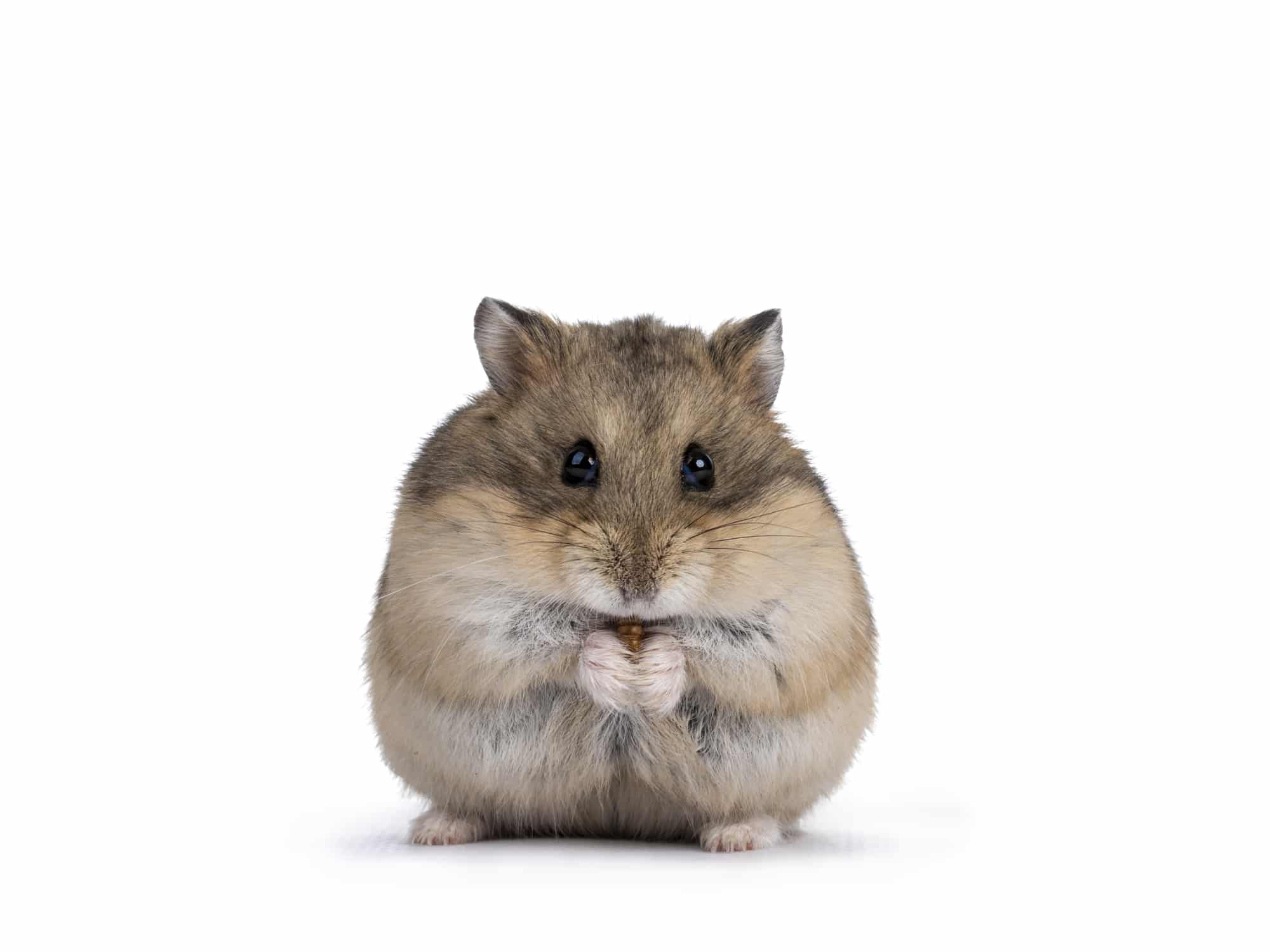When it comes to nutrition, mealworms are akin to fish. They contain high-quality protein, amino acids, and vitamins. However, despite all their health benefits, most humans prefer fish instead. But what about hamsters? Can hamsters eat mealworms? Are mealworms beneficial to the health of hamsters? Or can they make hamsters sick? Read this blog post to find out.
- Mealworms – Nutrition Data
- What can happen if your hamster eats mealworms?
- Can hamsters eat mealworms?
- FAQ
- Can mealworms cause infection in hamsters?
- Are mealworms bad for hamsters?
- Do hamsters need to eat mealworms to stay healthy?
- Can hamsters eat mealworm pupa?
- Can hamsters eat mealworm beetles?
- Can hamsters eat live mealworms?
- Where can you purchase live mealworms from?
- How to give live mealworms to your hamster?
- Can hamsters eat dried mealworms?
- Where can you purchase dried mealworms from?
- Can hamsters eat mealworms for birds?
- How to feed dried mealworms to your hamster?
- What to do if your hamster doesn't like dried mealworms?
- Fun Facts
- Conclusion
Mealworms – Nutrition Data
You can find the nutritional composition of mealworms below (Source: Mealworm Care):
| Live Mealworm | Dry (dead) Mealworm | |
| Protein | 20% | 53% |
| Fat | 13% | 28% |
| Fiber | 2% | 6% |
| Water | 62% | 5% |
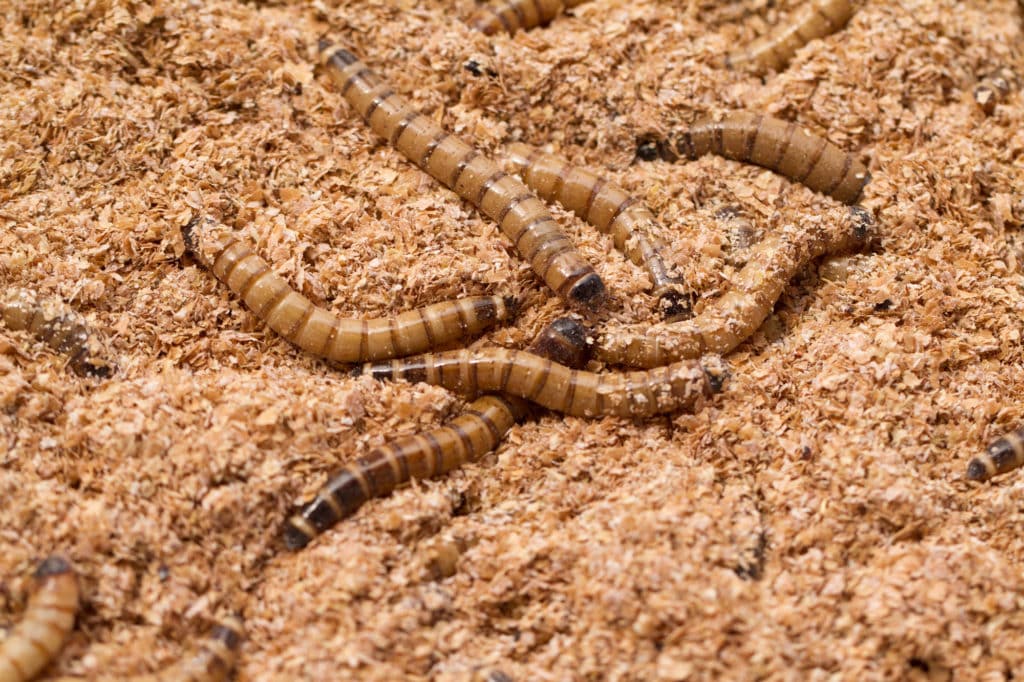
What can happen if your hamster eats mealworms?
Health benefits of mealworms
1. Mealworms are a great source of protein. Protein helps grow muscles. So, it is vital for your hamster because, unlike humans, hamsters keep running around a lot, which is a rigorous activity that needs strong muscles (Source: Dr. Health Benefits).
2. Mealworms are rich in proteins and low in calories. So, they can make your hamster feel full after eating a meal, thus helping keep his weight in check. Moreover, protein can also help improve metabolism and burn more calories (Source: Healthline). Thus, mealworms can help prevent obesity.
3. An improved metabolism translates into a better energy supply for the brain. Thus, mealworms can improve cognitive function.
4. Mealworms are nutrient-dense food. Hence, they can help avoid malnutrition.
5. Mealworms also contain all the nine essential amino acids (Source: Pet Food Industry). Amino acids aid the body in building proteins, hormones, and neurotransmitters. Amino acids also regulate the immune system and are essential for the digestive, reproductive, and nervous systems to function correctly (Source: Healthline).
6. Mealworms are also a rich source of beneficial omega-3 fatty acids like oleic and linoleic acids. Both these acids reduce inflammation and speed up the healing process (Source: PubMed). In addition to that, oleic acid can reduce blood pressure, lower cholesterol levels, urge the body to burn more fats, improve brain function, promote skin repair, and fight against infections and some types of cancers (Source: Dr.Axe). Linoleic acid promotes skin health, prevents coronary heart disease, reduces LDL (bad) cholesterol and the total amount of cholesterol in the body, improves insulin sensitivity, and helps reduce blood pressure (Source: Wikipedia, Harvard School of Public Health).
7. Mealworms can also improve digestion.
8. Mealworms are also excellent sources of zinc and magnesium. The body needs magnesium for several biological processes like the synthesis of proteins, DNA, and RNA; regulation of blood pressure and blood sugar levels; proper functioning of muscles and nerves; production of energy; structural development of bones, etc. (Source: The United States National Institute of Health). Zinc is an element that helps the immune system, improves metabolism, and enhances the body’s ability to heal.
9. The livestock we breed emit a lot of greenhouse gases and ammonia into the earth’s atmosphere, causing global warming. Indeed, food production is a major man-made cause of global warming, accounting for 25% of all the greenhouse gas emissions caused by human activities (Source: Food Navigator). But insects can reduce the impact of food production on the environment. After all, insects need far fewer resources – Space and food – to produce the same mass of food. So, their carbon footprint is far less when compared with livestock since they emit far less ammonia and greenhouse gases. Moreover, insects are far more economical to produce than conventional livestock. For example, insects can convert 2kg of food into 1kg of usable mass. In contrast, cattle need 8kg of food to produce 1kg of usable body mass (Source: Food Safety News). So, insects like mealworms can benefit the environment while being more economical to produce.
10. Storing mealworms is easy. Unlike traditional livestock meat, they don’t necessarily need to be refrigerated. Dry roasted mealworms can be stored for up to a year without being refrigerated. Moreover, they don’t take up much space either. Roasting mealworms removes the moisture in them while retaining most of their protein content and nutritional value. So, roasting is not an unhealthy process either.
Risks
Even though mealworms are a versatile source of proteins, offer several health benefits, and benefit the environment, they can be dangerous for your little hamsters when fed in excess. In particular, you must look out for the following health risks:
1. Mealworms, like shrimp, lobsters, prawns, oysters, and similar critters, contain two types of proteins – tropomyosin and arginine kinase – which can cause an allergy (Source: The Hive Explorer). If you are allergic to dust mites, shellfish, or crustaceans like lobster, crab, etc., you can be allergic to mealworms too. This is not true just for humans but for hamsters as well (Source: Youtube).
2. Mealworms are a great source of protein and healthy fats. But if overfed, mealworms can make your hamster obese.
3. Mealworms can be a healthy snack for your hamster. But if you feed too many mealworms to your hamster, he might consume less of other food items. This might deprive him of other essential nutrients causing malnutrition. So, you should give your hamster a balanced diet. This means that mealworms should only be used as an occasional treat.
4. Live mealworms can be a great way to provide your hamster fresh, nutritious protein. But live mealworms can bite. So, if your hamster stores the mealworms in his cheek pouch without killing them, they can bite and infect his cheek pouches. But cheek pouches are not the only body parts they can bite. Mealworms can also bite other body parts of a hamster, like his paws and nose, causing blood to well up and causing an infection. More on how to give live mealworms to your hamster later in this blog post.
5. Mealworms have an exoskeleton that is hard and contains some compounds that are difficult for hamsters to digest. So, some hamsters might have difficulty digesting them. This might lead to impaction – A lump of dry, hard stool getting stuck in the rectum – and result in more severe issues.
Mealworms may have several health benefits and a few risks. But the real question is if hamsters can eat them.
Can hamsters eat mealworms?
There are 19 different species of hamsters. So, to find out if a hamster can eat mealworms and how many mealworms he can eat, we have to find out how many mealworms the hamsters in his species can eat.
Can Chinese dwarf hamsters eat mealworms?
Yes, Chinese hamsters can eat mealworms. But they are tiny hamsters. That’s why they are called dwarf hamsters. So, they cannot eat as much food as other bigger species of hamsters. You can only give them a few mealworms every week. But don’t give everything in a single meal. The mealworms you give your Chinese hamsters should be distributed over the entire week. You should also cut the mealworms into small pieces so that your hamster doesn’t choke on them.
Can Campbell dwarf hamsters eat mealworms?
Yes, Campbell hamsters can eat mealworms. But just like Chinese hamsters, Campbell hamsters are also dwarf hamsters. So, all the rules that apply for Chinese hamsters also apply for Campbell hamsters. You can give them a few mealworms every week.
Can Russian dwarf hamsters eat mealworms?
Yes, Russian dwarf hamsters, also known as Djungarian hamsters or Winter White hamsters, can eat mealworms. But since they are also dwarf hamsters, give them no more than a few mealworms every week.
Can Roborovski hamsters eat mealworms?
Yes, Roborovski hamsters can eat mealworms. Roborovski hamsters are the smallest species of hamsters. But they are also one of the most active hamster species. If you observe them, you will notice that they keep running all the time. So, they can digest the carbohydrates and fats they eat faster than other dwarf hamsters. Therefore, they can eat more mealworms than other dwarf hamsters. You can give them 1 mealworm on alternate days.
Can Syrian hamsters eat mealworms?
Yes, Syrian hamsters can eat mealworms. As the largest pet hamster species, they can eat more mealworms than other pet hamsters – About 1 – 2 mealworms every day (Source: Squeaks and Nibbles).
FAQ
Can mealworms cause infection in hamsters?
If your hamster swallows a mealworm whole, it might cause an infection (Source: Pet Food Fuss). If that happens, your hamster’s body temperature might rise, and he will appear sick. In that case, take him to a veterinary doctor as soon as possible.
In addition to that, if your hamster eats too many mealworms at once, it could cause a blockage in his digestive system, which can quickly become dangerous. So, give mealworms in moderation and make sure they are either dried or dead. If you plan to give live mealworms to your hamster, you should make sure that your hamster kills the mealworm before eating it.
Are mealworms bad for hamsters?
Mealworms are not bad for hamsters if fed in moderation. But if fed in excess, mealworms can make your hamster obese due to their high fat content. Moreover, live mealworms can bite and infect your hamster. In addition to that, the exoskeleton of mealworms can also be hard for hamsters to digest. So, you should never give too many mealworms to your hamster at the same time.
Do hamsters need to eat mealworms to stay healthy?
Mealworms are a highly nutritious food. But it is not a food that hamsters cannot live without. Commercially available hamster pellets are enough to satisfy the nutritional needs of a hamster’s body. But you can include fruits and vegetables in your hamster’s diet to make it a balanced diet. All these food items are enough to keep a hamster healthy. So, you don’t need to give mealworms to your hamster if he is healthy. However, if your hamster looks weak, then you can try giving him mealworms.
Moreover, mealworms contain a lot of high-quality proteins and healthy fats. So, they can help your hamster recover faster. So, if your hamster is weak, you can give him mealworms so that he can heal and recover faster (Source: Tiny Pet Tales).
Can hamsters eat mealworm pupa?
Yes, hamsters can eat mealworm pupa. The shell of a pupa is not as hard as a mature mealworm’s. So, pupae are easier to digest than mealworms.
Can hamsters eat mealworm beetles?
Yes, just like the mealworms, the beetles are also rich in protein and fat. So, you can feed your hamster mealworms. But make sure you provide them only in moderation.
Can hamsters eat live mealworms?
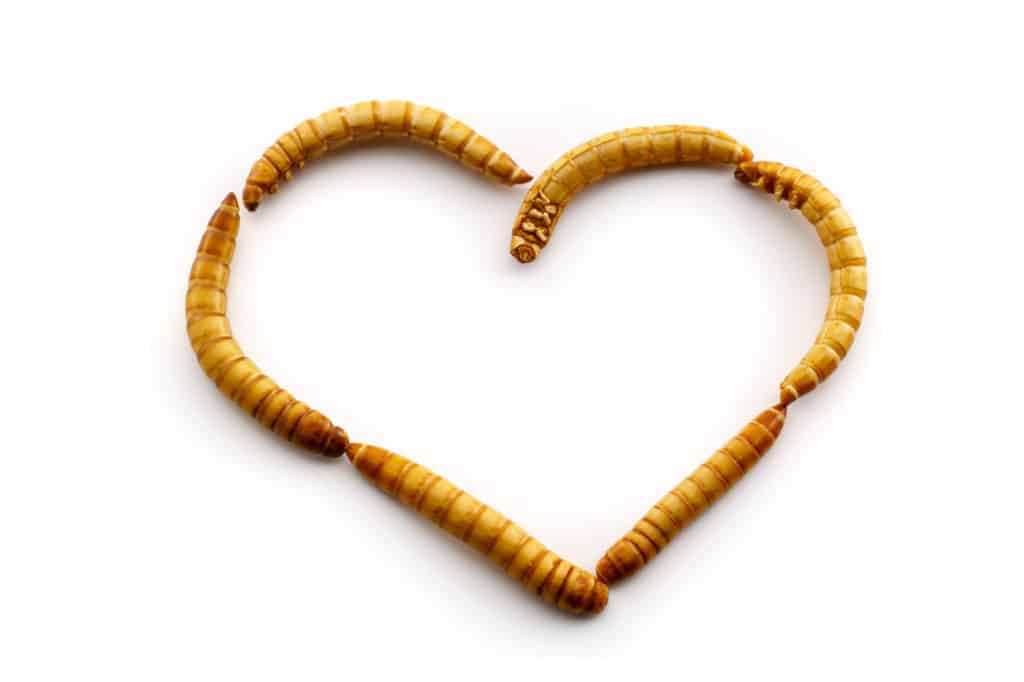
Yes, hamsters can eat live mealworms. Live mealworms are an excellent way to provide fresh, nutritious food to your hamster because they are much more similar to what your hamster would eat in the wild. But live mealworms are more difficult to find when compared to dried mealworms.
Where can you purchase live mealworms from?
You can buy them from some pet stores and sellers on Amazon. But regardless of whether you plan to buy from a pet shop or an online seller, make sure that the seller is reputable. Make sure that the seller has good reviews before purchasing live mealworms from them.
Do not buy too many mealworms in one go. Buy only as many mealworms as your hamster can eat before the mealworms turn into beetles. A mealworm takes 8 – 10 weeks to turn into a pupa, in which form the mealworm will stay for another 1 – 3 weeks. So, if you do not plan to give mealworm pupa and beetles to your hamster, you must finish all the live mealworms you purchased within 8 weeks. But it might be a difficult target to achieve if you own only one hamster. So, live mealworms are more suitable for pet owners who own multiple hamsters.
How to give live mealworms to your hamster?
If you plan to give live mealworms to your hamster, you should put them in your hamster’s food bowl before giving them to your hamster. If you put too many mealworms in the bowl, some of them might escape into your hamster’s bedding and start burrowing there. Some of them might even bite your hamster’s paw and nose. So, you should only give mealworms one at a time to your hamster.
But even if you give only one live mealworm to your hamster, if your hamster keeps it in his cheek pouch without killing it, it might bite him there. If he swallows him alive, he might get infected. So, crush the mealworm’s head before giving it to your hamster. If you want to give a live mealworm to your hamster and watch him forage for his food, then stay with your hamster until he kills the mealworm.
Can hamsters eat dried mealworms?
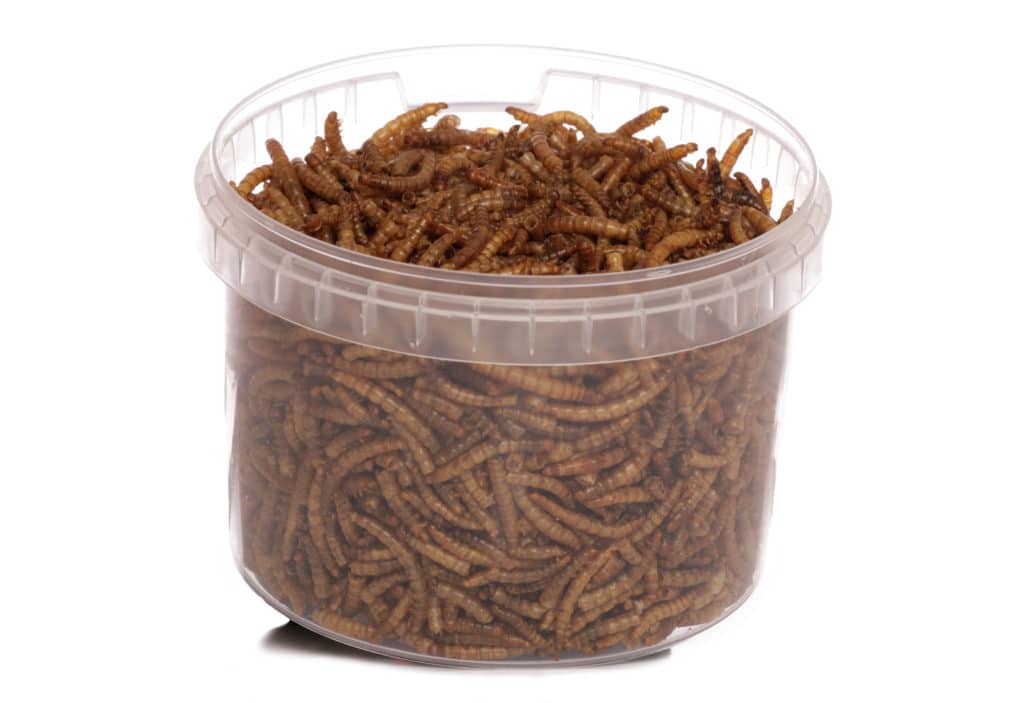
Of course, hamsters can eat dried mealworms. Indeed dried mealworms are the right choice if you have only one hamster (Source: Hamsters 101). Dried mealworms are very easy to find. Even though it is something your hamster would not eat in the wild, mealworms do not lose any of their nutrients when dried. Only their water content is lost, while the protein, fiber, and good fat content only get concentrated upon drying. So, dried mealworms are almost as nutritious as live mealworms.
Where can you purchase dried mealworms from?
You can purchase dried mealworms from many pet stores. Even if the packaging says that the mealworm is for another pet, you can buy it and use it for your hamster. But some hamsters may not like the taste of dried hamsters. So, purchase a small packet and try it out at first. If your hamster likes the taste of dried mealworms, you can buy a bigger packet next time.
Can hamsters eat mealworms for birds?
As explained above, hamsters can eat mealworms even if the packet advertises that the mealworms are for other pets. So, hamsters can eat mealworms for birds.
How to feed dried mealworms to your hamster?
You can put dried mealworms in your hamster’s food bowl to find out if your hamster likes their taste. If he likes the taste, you can scatter them across the bottom of his cage and watch him forage them.
What to do if your hamster doesn’t like dried mealworms?
Dried mealworms may be almost as nutritious as a live hamster. But they lack the flavor and taste that live mealworms have. So, there is a chance that your hamster may not like it, especially if he is picky. In such a case, you can give him live mealworms (one at a time) or remove mealworms from his diet altogether. But if you really want to give only dead mealworms to your hamster, you can crush the mealworm and mix it with his favorite food items. Some people have found success using this method (Source: Reddit).
Fun Facts
What are mealworms?
Mealworms are the larvae of the yellow mealworm beetle, Tenebrio Molitor, one of the 20,000 species of the darkling beetle (Source: Wikipedia).
Mealworms go through four life stages. But the amount of time a mealworm spends in each of these stages can vary depending on the food, water, temperature, and humidity. Let’s look at the four stages of a yellow mealworm beetle’s life below:
1. Egg
The egg is bean-shaped and white in color. It is as small as a speck of dust. An egg takes 1 – 4 weeks to hatch. Once the egg hatches, the larva emerges.
2. Larva
The larva stage is when the insect lives as a mealworm. This stage lasts 8 – 10 weeks. When the egg hatches, the mealworm will be very small. But with time, it will grow big and reach up to 1.5 inches in length.
During this stage, the mealworm has a hard exoskeleton that doesn’t expand. So, the mealworm has to molt and shed its exoskeleton to grow. A mealworm sheds its skin 10 – 20 times during the larva stage. The mealworm will be white and soft immediately after it sheds its skin, but soon, a new exoskeleton will form again. During this stage, the mealworm keeps eating most of the time in order to conserve energy for the next stage of life.
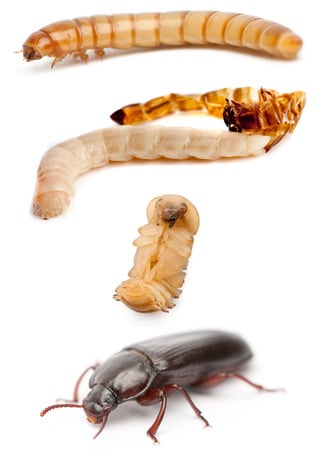
3. Pupa
Once the mealworm has shed its exoskeleton for the last time, it will reach this form – A white pupa. In this stage, the mealworm doesn’t have a mouth or an anus. So, it cannot eat. All it can do is wiggle as its organs and body transform into a beetle. This stage lasts 1 – 3 weeks.
4. Adult
This is the final stage of the insect’s life and lasts 1 – 3 months. At the beginning of this stage, the beetle has a soft, white exoskeleton. Its outer shell will gradually harden and become brown and finally black in the process. Even though these beetles do have wings, they cannot fly.
After 1 – 2 weeks as adults, beetles start mating. After mating, once the eggs have formed, the females burrow into a substrate or soil to lay eggs. A female beetle can lay hundreds of eggs during her lifetime.
Mealworms are decomposers. In the wild, they live in dark places, like under rocks, in animal burrows, and in leaf litter. Both the larva and the beetles consume what they are surrounded with – sticks, grass, leaf litter, feces, grains, dead insects, and dead animals. As pests, mealworms can be annoying. But as decomposers, they play a vital role in breaking down materials (dead plants, animals, insects, etc.), turning them into usable nutrients, and helping fertilize plants (Source: Sciencing). They also serve as nutritious food for rodents, reptiles, spiders, and wild birds.
Origin
Mealworms probably originated in the Mediterranean region. But as a result of human trade and colonization, they have spread throughout the world.
Conclusion
Mealworms are healthy food. They offer the following health benefits to our hamsters.
- They contain high-quality proteins and all the essential amino acids which help grow and maintain muscles.
- They contain very few sugars. So, they can help prevent obesity.
- They contain healthy fats which benefit various organs like the heart, skin, brain, etc.
- They help improve digestion.
- They are a good source of the minerals magnesium and zinc, which your hamster’s body needs to perform various functions.
But despite their health benefits, mealworms can also be dangerous for your hamster if overfed because they can cause digestion problems, allergies, infection, and make your furry friend obese. So, you should only feed mealworms to your furry friend in moderation as an occasional tasty treat.

